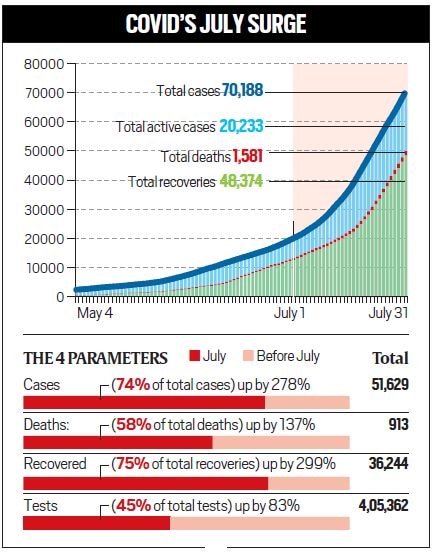- India
- International
Bengal: Covid load gets heavier after a grim July, testing times ahead
Health officials warn of steep virus curve if people keep defying protocols.
 Health workers in PPE suits collect swab samples of police officers for Covid-19 test, at a police station in Kolkata. (Express photo by Partha Paul)
Health workers in PPE suits collect swab samples of police officers for Covid-19 test, at a police station in Kolkata. (Express photo by Partha Paul)
While July marked West Bengal’s worst month during the Covid-19 pandemic, senior health officials believe the situation may worsen further if people do not take health protocols and restrictions seriously.
“In July, the situation was stressful. In August, it may even be more stressful. It will depend on human behaviour. We are ready to face any situation that prevails, and continuously we are increasing beds and medical facilities for Covid patients,” said Director of Health Services Ajay Chakraborty.
Last month, the state recorded 51,629 infections, constituting 74 per cent of its caseload, and 913 deaths, which marked 137 per cent increase over the fatalities in June. The surge in cases forced the government to admit that community transmission had started in some parts of the state.
 Last month, the state recorded 51,629 infections, constituting 74 per cent of its caseload, and 913 deaths, which marked 137 per cent increase over the fatalities in June.
Last month, the state recorded 51,629 infections, constituting 74 per cent of its caseload, and 913 deaths, which marked 137 per cent increase over the fatalities in June.
However, it was not all gloom and doom as the recovery rate picked up from July 19, and soared 10 percentage points to 68.92 per cent, and the government stepped up testing following an advisory from the Centre.
The number of patients discharged in July was 75 per cent of all recoveries. The case fatality rate was also 1.77 per cent, well below the national average, because of the high number of cases. Meanwhile, the 83 per cent increase in testing was responsible, to an extent, for the rise in the test positivity rate from 3.8 per cent at the end of last month to 7.86 per cent on July 31. The monthly positivity rate was a massive 12.7 per cent.

The bulk of the 278 per cent increase in cases, and fatalities were reported from the pandemic epicentre in South Bengal comprising Kolkata, its adjoining districts North 24 Parganas, Howrah, South 24 Parganas; and Hooghly.
In North Bengal, another area of concern, the government had to impose a total shutdown in five cities from July 15. The region saw its caseload swell by 263 per cent — fuelled by a surge in districts such as Dakshin Dinajpur (over 400 per cent rise in cases), and Darjeeling (over 300 per cent increase).
However, recoveries also picked up in districts such Dakshin Dinajpur and Malda, and by the end of the month the discharge rate in North Bengal was up to 75 per cent. On July 15, as cases surged, it was 66.78 per cent.
While districts such as Paschim and Purba Bardhaman also registered over 400 per cent jump in cases, the notable exceptions were Jhargram, Alipurduar, Kalimpong, and Birbhum. These districts added fewer cases in July compared to the month before.
Sounding a warning, a senior Department of Health official said, “People of the state are very reluctant about the infection rate and other fatal aspects of this disease. So, if people are not aware, how can someone expect the caseload to decrease? People are not at all maintaining the precautions to contain the infection.”
Renowned virologist Suman Poddar said, “The situation is going to be even worse in August. If the government is serious about the biweekly lockdown, then the situation may improve. But, it will actually not happen. We basically need a 15-day strict lockdown to take control of the situation. Otherwise, August and September will be even worse.”
Apr 19: Latest News
- 01
- 02
- 03
- 04
- 05






































